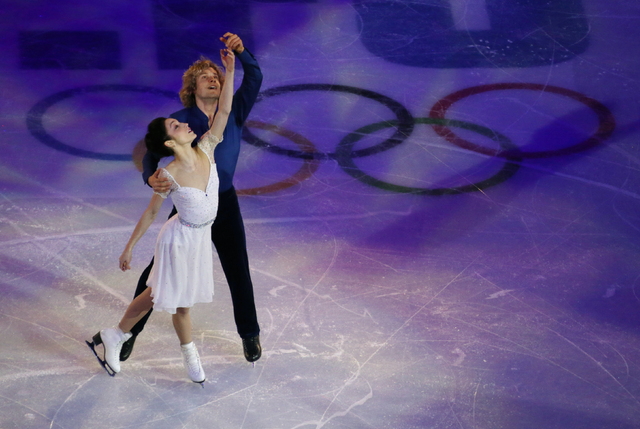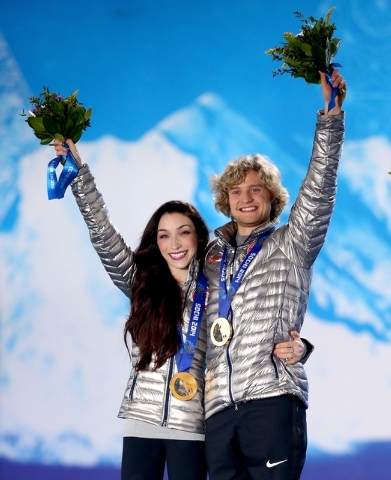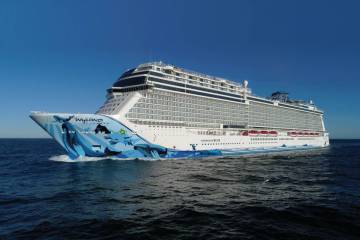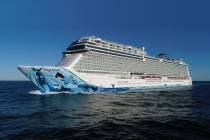Former olympic skaters show their expert chops in show at Mandalay Bay
For a desert mecca, Las Vegas has a definite thing for ice.
But we’re not talking cubes in a glass. Or hockey. Or the long-gone (and probably unlamented) “Nudes on Ice.”
No, we mean real live Olympic medalists out there on the ice, leaping and gliding and spinning, sometimes to the accompaniment of real live musicians.
The tradition continues Saturday at Mandalay Bay, when several champions team up with rockers O.A.R. (alias Of A Revolution) for “Home Is Where the Heart Is.”
Part of the “Pandora Unforgettable Moments of Love on Ice” series, the show will be recorded for Jan. 31 and Feb. 14 telecasts on ABC.
But it’s the live-and-in-person aspect of the show that intrigues many participants, including Meryl Davis and Charlie White, who captured ice-dancing gold at this year’s Winter Olympics. (Afterward, they changed partners to compete on “Dancing with the Stars” — Davis won and White finished fourth.)
Among those joining Davis and White on the ice Saturday at Mandalay Bay: Olympic gold medalists Brian Boitano (1988) and Evan Lysacek (2010); 1994 and 1998 silver medalist Elvis Stojko (Elvis on ice!); 2006 silver medal-winning ice dancers Tanith Belbin and Ben Agosto; 2006 world champion Kimmie Meissner; and three-time U.S. champ Michael Weiss (1999, 2000, 2003), who’ll host the show with 1992 Olympic gold medalist Kristi Yamaguchi.
“When you have a live performance, there’s an energy it brings,” White says in a telephone interview from the duo’s Detroit base. “You can feel the energy from the crowd — and from the performers.”
That sentiment also holds true for O.A.R., says Jerry DiPizzo, who plays saxophone in the band alongside singer and guitarist Marc Roberge, drummer Chris Culos, guitarist Richard On, bassist Benj Gershman and keyboardist Mikel Paris.
After all, “we’re a band that’s known for our live shows” — more than a hundred every year, DiPizzo says. (Saturday’s ice show marks the group’s 2014 finale.)
But playing live means “we play songs different every single night” — except at Saturday’s ice show, when, he says, they’ll have to “cater to the skater” with a fairly exact arrangement.
“We spent a lot of time getting the right songs to fit,” DiPizzo says.
For Boitano, who estimates he’s skated to probably around 50 live musical performances, the key is finding a song you connect with, he says.
He says he usually look for songs that have a rhythm that he can choreograph and skate to, but he’s also interested in something the audience can enjoy.
This time around, Boitano will skate to O.A.R.’s “Shatter,” while Davis and White will skate to the group’s live performance of “Peace.”
Davis and White choreographed their own moves to the “absolutely beautiful song” that “Charlie and I are really excited to be skating to,” Davis says in a separate telephone interview.
White agrees, saying, “It’s a really great song to skate to. We were so relieved. It’s really nice when the choreography flows.
“As ice dancers, we tap into what’s already there (in the music).”
Davis says the approach is different than competitive skating.
“What works in a competitive setting isn’t necessarily what works in an entertainment setting.”
That’s something Boitano has experienced firsthand since he won the “Battle of the Brians” (vs. Canada’s Brian Orser) during the 1988 Winter Olympics in Calgary.
“Back in the day, you prepared four or five numbers and just did them all the time,” he says.
Through the years, however, post-Olympic skating has grown to encompass “world tours and TV specials” that focus on the sport’s more entertainment-oriented aspects, in Boitano’s view. “It’s developed into more than just skating.”
Yet that combination of athletics and aesthetics is at the heart of skating’s appeal, says White, who grew up playing hockey before becoming a medal-winning ice dancer.
“What you’re able to do — combining athletics, artistry and telling a story — it can be really special,” he says.
Competing on “Dancing with the Stars” has given Davis a new appreciation for skating.
“The rules of physics change when you don’t have blades on your feet,” she says. “(In skating) there’s definitely something very pleasing about the continuity of movement — the ability to glide.”
Davis and White have never performed in Las Vegas (they’ve never even been to Las Vegas), but Boitano has skated here several times.
He has particularly fond memories of an outdoor 1988 Caesars Palace show that featured a cast of Olympic all-stars.
“Was that an amazing time,” Boitano says, adding that the show “stands out to everyone that was in it.”
The show was unusual, because it was outdoors, he says. But he also remembers wishing he had earplugs because of how loud the music was.
That was more than a quarter-century ago, but Boitano’s “still got it” on the ice, White says. “He’s such an amazing performer.”
And that’s part of the fun of participating in a show like Saturday’s, according to Davis.
Unlike competitive events that pit them against contemporaries, she says, “we’re getting a chance to do some shows and skate with our idols.”
Boitano says skaters are probably the luckiest Olympic athletes, because “there’s a whole life after amateur skating — and you can still skate.”
Not that it gets easier.
“I have to train even harder,” Boitano says. And even with dedicated training, “it’s the most frustrating thing in my entire life,” trying to reconcile his “20-year-old mind” with his 51-year-old body.
But “I love skating, so why not keep working?” he says. “It’s a creative outlet — and I love meeting people.”
That includes the musicians whose songs he’s skated to — with O.A.R. the latest in a long list.
“We probably won’t be playing any metal songs,” DiPizzo jokes, noting how he and his fellow musicians compiled the show’s song list by asking themselves, “How would someone be able to skate to this?”
Most of the selections are from the group’s most recent album, “The Rockville LP” (named for Roberge and Culos’ hometown of Rockville, Md.), which, focuses on “being home, cherishing the people in your life and what centers you,” he says. “That’s our bread and butter — it’s right in our wheelhouse.”
And though they’ll be concentrating on getting the music right, DiPizzo and his bandmates will be excited to see them in the flesh, especially because of “what it takes to try and be … a world-class athlete.”
Those world-class athletes, meanwhile, are happy to relax and skate without the pressure of the moment that accompanies Olympic competition — and pleasing the judges, White acknowledges.
“That’s what’s so wonderful about performances — just our ability to connect with the crowd and approach the sport from the entertainment side,” he says. “You can laugh and have fun” and “imbue the programs themselves with that joy.”
Contact reporter Carol Cling at ccling@reviewjournal.com or 702-383-0272.
Preview
"Pandora Unforgettable Moments of Love on Ice"
7:30 p.m. Dec. 20
Mandalay Bay Events Center, 3950 Las Vegas Blvd. South
$35-$115 (800-745-3000, www.ticketmaster.com)























